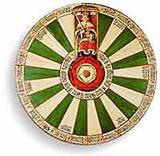

Explorations in Arthurian History
A Literature ReviewPart 4: Wace, Layamon, and the Alliterative Morte Arthur
A Frenchman named Wace was so impressed with Geoffrey of Monmouth's History of the Kings of Britain that he wanted to write his own version. He did so, calling it Roman de Brut. Wace started with Brutus the Trojan, as did Geoffrey, and traced the lineage of British rulers down through the years. In Wace's work (which is verse, not prose) we see the rise of romantic love, a concept so tantamount to our modern understanding of the Matter of Britain that it is difficult to imagine a time when such things weren't part of discussions of matters Arthurian. Yet, there it is: Wace gives us the first glimpse of courtly love. He also gives us the first picture of the Round Table: Wace says that Arthur established the Round Table,
but he doesn't say Arthur sat at it. This is our first glimpse
of the concept, and it is a rough one indeed. The knights sit
inside the circle that the table forms. Arthur sits on a dais,
at a higher table, in the world of Wace. The importance of his idea
is not that Arthur sit equal with his knights but that they all sit
equal with each other. Again, this is an idea that was not part of
the Matter of Britain until Wace wrote Roman de
Brut. Wace also gives us the familiar name of Arthur's
swordExcalibur,
adapting Geoffrey's Caliburn.
The contributions of Wace to the popular lexicon of Arthurian terms
cannot be overstated.
From France back to Britain we go for
another Brut, this one by a parish priest in
Worcestershire. His name: Layamon.
His masterwork is also his only work, but it is a masterwork
indeed. He borrows full swing from Wace in translating the
Roman de Brut into English and then piles on concepts
of his own, including the idea that all that courtly love
Wace introduced shouldn't be in there in the first place.
Whereas Wace used imagery and vivid language to enhance his
descriptions of deeds and loves, Layamon hearkens back to
the AngloSaxon days, when things were straightforward and
warriors didn't have time to pursue affairs because they
were too busy keeping themselves from being killed in
battle. As such, we are back to Welsh roots. The importance of Layamon's Brut is the
focal point's being Arthur himself, with a court at London. In
previous and successive versions of events, Arthur and his court or
capital are the backdrop before which other characters have
adventures. To Layamon, Arthur is the story. According to
Layamon, Arthur's life is nasty, brutish, and short. Layamon does include the Round Table, of course,
although his is the product of a chance meeting between Arthur and a
Cornwall carpenter who offered to make a table that could be folded
up and carried anywhere while at the same be able to seat 1,600. The
number, as with many numbers in historical tradition, is suspect. In
fact, the entire description of this Round Table is open to question.
But in Brut it resides. Lastly, Layamon continues the perception that
Arthur will come again, quoting Merlin
as saying, "that an Arthur should yet come to help the
English."
The last examination in our historical
journey is the "alliterative Morte Arthure," a poem
written during the late 14th century. The anonymous author
set out to write an Arthurian story but at the same time be
bound by the rules of alliteration. As such, the story is
alive with a rich vocabulary, full of obscure words and
resonant phrases. The main source is Geoffrey of Monmouth,
though elements of Wace and Layamon enter in as well. And as
with these authors, the imagery therein echoes the signs of
the times. Descriptions of battles and landscapes mirror
historical events. This was true of Geoffrey as well and
explains why the Bretons are Arthur's best allies: Geoffrey
was writing at the height of the Norman Period, after
all. Echoing Layamon, the Morte Arthure
presents Arthur as a towering figure, bound not by court
conventions but by the code of survival. Arthur is cruel,
commanding, and majesticall at the same time. He towers
over other figures (including Gawain
and Mordred
and Kay
and Bedivere)
in a way that hasn't been seen since. Thus we reach the end of the search for a
historical Arthur in literature. To find a rounder picture,
we must turn to geography. To continue paging through the ideals of
Arthurian literature (with the understanding that it is now
the stuff of legends, not facts) click here.




Explorations in Arthurian History and Legends
Main
Page
Other
© 2000-2009 David White